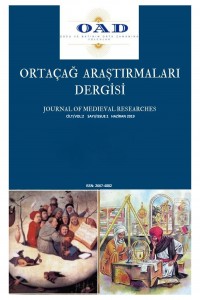Abstract
Manastır sistemi özellikle hayırseverlik işlevi açısından
Bizans sosyal ve ekonomik yaşamı için hayatidir. Neredeyse tüm Bizans toplumu
imparatorluk tarihi boyunca ihtiyaç sahibi insanların çeşitli ihtiyaçlarını
kendi ekonomik temellerine dayanarak karşılayan manastır kuruluşlarına
mensuptu. Bu yüzden Bizans toplumu içinde manastır sistemi farklı toplumsal
katmanlardaki insanların arasında köprü işlevi gören yardımseverlik ve hayır
kuruluşları vasıtasıyla gözlemlenebilir. Bununla birlikte tüm bu yardım etkinliklerinin
gerçekleştirilebilmesi ve hayır kuruluşlarının görevlerini yerine
getirebilmeleri için güçlü ekonomik temellere ihtiyaç vardır. Oysaki
Palaiologan dönemindeki ekonomik zorluklar geç Bizans döneminin en varlıklı
manastırlarını ve onların etkinliklerini bile olumsuz etkilemiştir. Dolayısıyla
Konstantinopolis Manastırlarının bu hayır işlerini mümkün kılan finansal
kaynaklarının tabiatını incelemek geç Bizans dönemi sosyo-ekonomik tarihini
daha iyi anlamak için gereklidir.
References
- Charanis, Peter; “The Monastic Properties and the State in the Byzantine Empire,” Dumbarton Oaks Papers4, 51-118.
- Charanis, Peter; “The Monk as an Element of Byzantine Society,” Dumbarton Oaks Papers25, 61-84.
- Constantelos, Demetrios J.; Byzantine Philanthropy and Social Welfare, Rutgers University Press, New Jersey, 1968.
- Constantelos, Demetrios J.; Poverty, Society and Philanthropy in the Late Medievael Greek World, The Speros B. Vryonis Center for the Study of Hellenism, New York, 1992.
- Erdoğan, Esra Güzel, Ayla Ödekan, and Nevra Necipoğlu; "II. Andronikos Dönemi Konstantinopolis Manastırlar'nda Philanthropia," İTÜ Sosyal Bilimler Dergisi 6, no. 2 (December 2009): 27-40 .
- Miller, Timothy S.; The Birth of the Hospital in the Byzantine Empire, The Johns Hopkins University Press, Baltimore, 1985.
- Necipoğlu, Nevra; “Byzantine Monasteries and Monastic Property in Thessalonike and Constantinople During the Period of Ottoman Conquest,” Osmanlı Araştırmaları XV, 123-135.
- Smyrlis, Kostis.; La Fortune Des Grands Monasteres Byzantins, Association des Amis de Centre d’Histoire et Civilisation de Byzance, Paris, 2006.
- Smyrlis, Kostis; The State, the Land and Private Property, Confiscating Church and Monastic Properties in the Palaiologan Period, in Church and Society in Late Byzantium, ed. D. Angelov (Kalamazoo: Medieval Institute Publications, 2009), 58-87.
- Talbot, Alice-Mary;"An Introduction to Byzantine Monasticism," Illinois Classical Studies12, no. 2, 229-41.
- Talbot, Alice-Mary;“Monasticism in Constantinople in the Final Decades of the Byzantine Empire,” 550th Anniversary of the Istanbul University International Byzantine and Ottoman Symposium (XVth Century), 295-308.
- Talbot, Alice-Mary; “The Restoration of Constantinople under Michael VIII,” Dumbarton Oaks Papers47, 243-261.
- Thomas, John and Angela Constantinides Hero, eds.; Byzantine Monastic Foundation Documents, Dumbarton Oaks, Washington D.C, 2000.
- Thomas, John Philip; Private Religious Foundations in the Byzantine Empire, Dumbarton Oaks, Washington D.C, 1987.
PHILANTHROPY IN CONSTANTINOPOLITAN MONASTERIES AND THEIR FINANCIAL RESOURCES IN THE PALAIOLOGAN PERIOD
Abstract
The institution of monasticism was a vital component
of the Byzantine social and economic life especially in terms of their
philanthropic functions. Almost entire Byzantine society was attached to
monastic foundations which satisfied various needs of the destitute people
depending on their economic bases throughout the empire’s history. Therefore,
the visibility of the institution of monasticism within the Byzantine society
was mainly based on its philanthropic activities and charitable institutions
that built the bridge between people from different social strata. After all,
these philanthropic activities and institutions necessitated a strong economic
power to remain to function. However, the economic hardships within the
Palaiologan period had a negative impact even on the wealthiest monasteries of
the late Byzantine Empire and their philanthropic activities. Therefore, it is
necessary to analyze the nature of the financial resources of
Constantinopolitan monasteries that made philanthropic activities possible in
order to have a better comprehension of the Late Byzantine socio-economic
history.
References
- Charanis, Peter; “The Monastic Properties and the State in the Byzantine Empire,” Dumbarton Oaks Papers4, 51-118.
- Charanis, Peter; “The Monk as an Element of Byzantine Society,” Dumbarton Oaks Papers25, 61-84.
- Constantelos, Demetrios J.; Byzantine Philanthropy and Social Welfare, Rutgers University Press, New Jersey, 1968.
- Constantelos, Demetrios J.; Poverty, Society and Philanthropy in the Late Medievael Greek World, The Speros B. Vryonis Center for the Study of Hellenism, New York, 1992.
- Erdoğan, Esra Güzel, Ayla Ödekan, and Nevra Necipoğlu; "II. Andronikos Dönemi Konstantinopolis Manastırlar'nda Philanthropia," İTÜ Sosyal Bilimler Dergisi 6, no. 2 (December 2009): 27-40 .
- Miller, Timothy S.; The Birth of the Hospital in the Byzantine Empire, The Johns Hopkins University Press, Baltimore, 1985.
- Necipoğlu, Nevra; “Byzantine Monasteries and Monastic Property in Thessalonike and Constantinople During the Period of Ottoman Conquest,” Osmanlı Araştırmaları XV, 123-135.
- Smyrlis, Kostis.; La Fortune Des Grands Monasteres Byzantins, Association des Amis de Centre d’Histoire et Civilisation de Byzance, Paris, 2006.
- Smyrlis, Kostis; The State, the Land and Private Property, Confiscating Church and Monastic Properties in the Palaiologan Period, in Church and Society in Late Byzantium, ed. D. Angelov (Kalamazoo: Medieval Institute Publications, 2009), 58-87.
- Talbot, Alice-Mary;"An Introduction to Byzantine Monasticism," Illinois Classical Studies12, no. 2, 229-41.
- Talbot, Alice-Mary;“Monasticism in Constantinople in the Final Decades of the Byzantine Empire,” 550th Anniversary of the Istanbul University International Byzantine and Ottoman Symposium (XVth Century), 295-308.
- Talbot, Alice-Mary; “The Restoration of Constantinople under Michael VIII,” Dumbarton Oaks Papers47, 243-261.
- Thomas, John and Angela Constantinides Hero, eds.; Byzantine Monastic Foundation Documents, Dumbarton Oaks, Washington D.C, 2000.
- Thomas, John Philip; Private Religious Foundations in the Byzantine Empire, Dumbarton Oaks, Washington D.C, 1987.
Details
| Primary Language | English |
|---|---|
| Journal Section | Research Articles |
| Authors | |
| Publication Date | June 19, 2019 |
| Submission Date | April 25, 2019 |
| Published in Issue | Year 2019 Volume: 2 Issue: 1 |
Cite
Articles published in Ortaçağ Araştırmaları Dergisi are licensed under a Creative Commons Attribution-NonCommercial 4.0 International License (CC BY-NC 4.0). Ortaçağ Araştırmaları Dergisi provides immediate open-access to its content, reflecting its conviction in advancing global knowledge exchange. The opinions presented in the articles are the sole responsibility of their respective authors and do not present the view or opinions of Ortaçağ Araştırmaları Dergisi. Terms of Use & Privacy Policy




